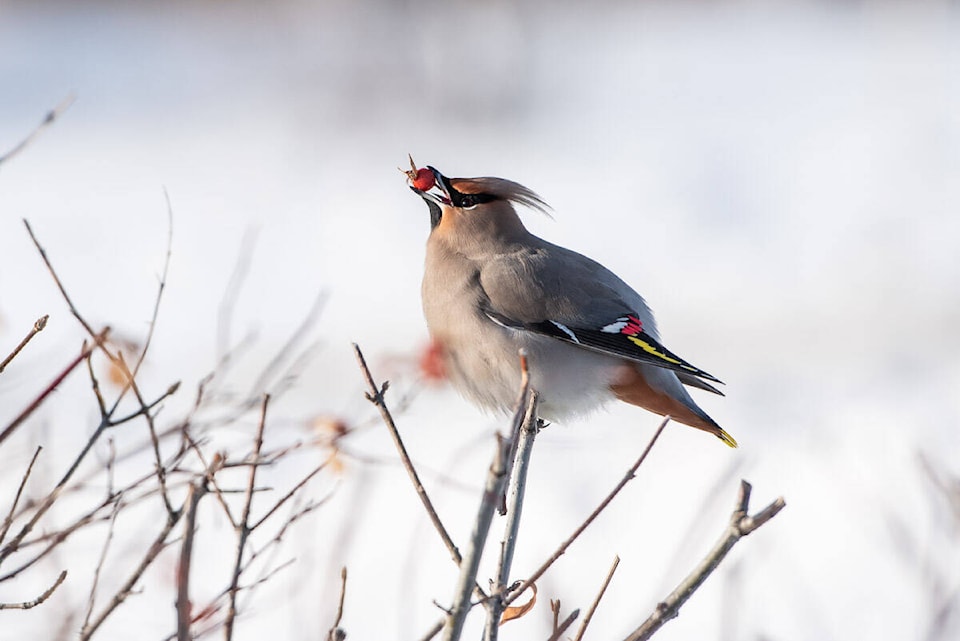You’re unlikely to see a partridge in a pear tree in the Yukon, but join in on the Christmas Bird Count and you will spot some familiar feathered friends.
“When you talk about birds, pretty well everyone has a story that they love to share. Whether it’s watching at a feeder or where they’re walking in their woods,” said Haines Junction birder Julie Bauer. “It just opens up so many windows, the discussion on birds and people’s enjoyment of them.”
Bauer is one of the organizers behind the Yukon edition of the Christmas Bird Count, a tradition for some nature lovers across the country that goes back over a hundred years.
It hasn’t been going on quite that long in the Yukon, but Bauer has been running the territory’s west-end event since 2007. Counts take place all around the Yukon, most of them on Boxing Day.
Birders and casuals alike will be heading out on walks, bikes, skis and hikes to record the number of birds they see and compile that data as part of a much broader citizen science initiative that can provide long-term trends on how birds are doing.

“I’ve always been interested in what we call citizen science or community-based science,” said Sebastian Jones, who runs the count in Dawson City and Tombstone Territorial Park.
“If you’re doing these longer-term, observational things with much the same protocol, you can actually start to provide some really useful insights into what’s going on in the landscape. The power of these things is that the more you do it, and the longer you do it — so with thousands of bird counts being done — it becomes a really robust data set. It’s real science,” he said.
“And it’s always fun to go and look for birds and hear about what other people have seen too. Especially when we do the Tombstone one, it’s also a fun outing in the middle of the wintertime,” he said.
This year walks will take place in several communities, including on Boxing Day in Dawson City, Johnson’s Crossing, Kluane Lake, Watson Lake and Whitehorse.
Walks will take place on Jan. 2 in Tombstone Territorial Park and in Takhini-Laberge, Dec. 29 in Mayo, Dec. 18 in Carcross and on Dec. 19 in Tagish, Teslin, Marsh Lake, Haines Junction.
Jim Hawkings organized the data from last year’s count for the Whitehorse area, meaning he communicated with other groups who were taking a walk, bike or ski and recording the birds they saw while out.
“We’ve never had a sort of big group thing here except for a gathering after the count. That’s obviously not happening with COVID, so we had Zoom calls instead. As far as the count itself goes, it’s pretty much business as usual. That’s one of the good things about it is it doesn’t require a lot of stuff that is a bit risky in COVID,” said Hawkings.
He said Whitehorse is such a large area that people are often welcome to join in on the count – all that is required is noting the time out, route and the number of each species that is spotted.

Small groups or individuals interested in covering their own ground can coordinate with the Yukon Bird Club by visiting their website at yukonbirds.ca. People with bird feeders who can dedicate some time to spot and count birds are also welcome to contribute.
“It’s always good fun and the more the merrier,” said Hawkings.
Most of the time winter birding in the Yukon is fairly predictable.
“Usually, in early December, I start asking people, are you seeing any unusual birds? Because usually by December, whatever birds you see are usually around there for the winter and not migrating,” said Bauer. “If there is something unusual we try and catch it on the Christmas Bird Count because we’re always trying to get as many species as possible and to document the unusual birds.”
Ravens and chickadees dominate counts, joined by the occasional hardy robin or junco. Ptarmigan, whiskey jacks, eagles, sparrows, dippers and nuthatches are all other familiar faces this time of year. Yukon also has wintering owls, but they can be harder for an untrained eye to spot.
But last year brought a few surprises to the various Yukon regions. In the southern Yukon the Steller’s jay, normally confined to British Columbia, was spotted in unusually high numbers, even late in the season.
One year Jones said birders who made the trek out to Tombstone Territorial Park were treated with a glimpse at the gyrfalcon, the largest of the falcon species, who remain in the park during the winter.
And although it didn’t make an appearance on the Boxing Day count, dedicated birders from around the territory got a late Christmas present last year in Haines Junction when a wayward hawfinch was spotted.
It was the first time the species was ever recorded in Canada. Normally the handsome songbird spends the winter in Japan.
“I had my best count ever, because we had all these birders from Whitehorse looking for the hawfinch,” said Bauer. While the colourful finch evaded birders on the day of the count, it reappeared on Dec. 29 in Bauer’s backyard.
“I’ll never get that again. It was a unique bird. Just because it had never been seen and documented in Canada before,” she said.
Even without a once-in-a-lifetime sighting, Bauer said she enjoys the Christmas Bird Count because it encourages people to appreciate their local species and get outside.
While on hold right now because of COVID-19, she’s also looking forward to bringing back the Christmas Bird Count for kids events aimed at younger Yukoners.
“Kids loved that. Most Yukoners, especially if their parents are hunters, have got binoculars and stuff like that. So just starting them out using the binoculars properly and getting the idea to go out and look at their feeder, is a lot of fun,” she said.
Contact Haley Ritchie at haley.ritchie@yukon-news.com
